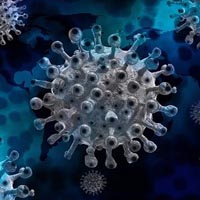Sex difference in hospitalized patients with COVID-19 infection

Accepted: 29 September 2021
All claims expressed in this article are solely those of the authors and do not necessarily represent those of their affiliated organizations, or those of the publisher, the editors and the reviewers. Any product that may be evaluated in this article or claim that may be made by its manufacturer is not guaranteed or endorsed by the publisher.
The pandemic of COVID-19 infection is rapidly progressing to one of the most severe threats to human health. The different responses of the immune system in females and males to a range of infectious and inflammatory stimuli were investigated. We aimed to explore the association of sex with the course of infection among the hospitalized COVID-19 patients. This Comparative cross-sectional study was conducted on RT- PCR positive COVID-19 patients. Severe and critical patients who required hospital or ICU admission were included in the study. The total number of patients was 150 (75 males and 75 females) with mean age of 57Y±14.7. There was a statistical significance in age between both groups [mean ± SD: males 60.5 (12.2), females 54 (15.3) (p=0:0.007)]. The prevalence of diabetes mellitus, hypertension, chronic kidney disease and ischemic heart disease was higher among males but without statistical significance. Consolidation was significantly more prevalent in female group (85.3% vs 61.3% in male group). The need of mechanical ventilation was higher in men, but with no statistical significance (44% Vs 32%, p=0.302). Also, mortality rate was higher (48%) in males than in females (37.3%), but with no statistical significance (p=0.262). During the COVID-19 infection, the risk factors of severe disease and progression to the need of mechanical ventilation support in addition to mortality rate are more prevalent among males. However, radiological patterns apart from consolidation, distribution of radiological abnormalities and CT severity score in both groups did not show significant sex difference.
Pérez-López FR, Tajada M, Savirón-Cornudella R, et al. Coronavirus disease 2019 and gender-related mortality in European countries: A meta-analysis. Maturitas 2020;141:59-62.
WHO. Clinical management of severe acute respiratory infection when COVID-19 is suspected. Accessed May 10, 2020. Available from: https://www.who.int/publications-detail/clinical-management-of-severe-acute-respiratory-infection-when-novel-coronavirus-(ncov)-infection-is-suspected
WHO. Corticosteroids for COVID-19. Accessed December 4, 2020. Avaiable from: https://www.who.int/publications/i/item/WHO-2019-nCoV-Corticosteroids-2020.1.
Ranieri VM, Rubenfeld GD, Thompson BT, et al. Acute respiratory distress syndrome: The Berlin definition. JAMA 2012;307:2526-33.
Conti P, Younes A. Coronavirus cov-19/sars-cov-2 affects women less than men: Clinical response to viral infection. J Biol Regul Homeost Agents 2020;34:339-43.
Quakkelaar ED, Melief CJM. Experience with synthetic vaccines for cancer and persistent virus infections in nonhuman primates and patients. Adv Immunol 2012;114:77-106.
Hansell DM, Bankier AA, MacMahon H, et al. Fleischner Society: Glossary of terms for thoracic imaging. Radiology 2008;246:697-722.
Pan F, Ye T, Sun P, et al. Time course of lung changes at chest CT during recovery from Coronavirus disease 2019 (COVID-19). Radiology 2020;295:715-721.
Wiersinga WJ, Rhodes A, Cheng AC, et al. Pathophysiology, transmission, diagnosis, and treatment of coronavirus disease 2019 (COVID-19): A review. JAMA 2020;324:782-793.
Klein SL. The effects of hormones on sex differences in infection: from genes to behavior. Neurosci Biobehav Rev 2000;24:627-38.
Huang C, Wang Y, Li X, et al. Clinical features of patients infected with 2019 novel coronavirus in Wuhan, China. Lancet 2020;395:497-506.
Goujon A, Natale F, Ghio D, et al. Age, gender, and territory of COVID-19 infections and fatalities. EUR 30237 EN, Publications Office of the European Union, Ispra, 2020.
Guzik TJ, Mohiddin SA, Dimarco A, et al. COVID-19 and the cardiovascular system: Implications for risk assessment, diagnosis, and treatment options. Cardiovasc Res 2020;116:1666-87.
Shi S, Qin M, Shen B, et al. Association of Cardiac Injury with Mortality in Hospitalized Patients with COVID-19 in Wuhan, China. JAMA Cardiol 2020;5:802-10.
Istituto Superire di Sanità. Characteristics of COVID-19 patients dying in Italy. Accessed December 6, 2020. Available from: https://www.epicentro.iss.it/en/coronavirus/sars-cov-2-analysis-of-deaths
Dorigo P, Fraccarollo D, Santostasi G, Maragno I. Impairment of endothelium-dependent but not of endothelium-independent dilatation in guinea-pig aorta rings incubated in the presence of elevated glucose. Br J Pharmacol 1997;121:972-6.
Perticone F, Ceravolo R, Pujia A, et al. Prognostic significance of endothelial dysfunction in hypertensive patients. Circulation 2001;104:191-6.
He L, Mäe MA, Muhl L, et al. Pericyte-specific vascular expression of SARS-CoV-2 receptor ACE2 – implications for microvascular inflammation and hypercoagulopathy in COVID-19. BioRxiv, May 2020. doi:10.1101/2020.05.11.088500
Yan R, Zhang Y, Li Y, et al. Structural basis for the recognition of SARS-CoV-2 by full-length human ACE2. Science 2020;367:1444-48.
Froldi G, Dorigo P. Endothelial dysfunction in Coronavirus disease 2019 (COVID-19): Gender and age influences. Med Hypotheses 2020;144:110015.
Moradi B, Ghanaati H, Kazemi MA, et al. Implications of sex difference in CT scan findings and outcome of patients with COVID-19 pneumonia. Radiol Cardiothorac Imaging 2020;2:e200248.
Dangis A, De Brucker N, Heremans A, Gillis M, Frans J, Demeyere A, Symons R. Impact of gender on extent of lung injury in COVID-19. Clin Radiol 2020;75:554-6.
Kloc M, Ghobrial RM, Kubiak JZ. The role of genetic sex and mitochondria in response to COVID-19 infection. Int Arch Allergy Immunol 2020;181:629-34.
Chanana N, Palmo T, Sharma K, et al. Sex-derived attributes contributing to SARS-CoV-2 mortality. Am J Physiol Endocrinol Metab 2020;319:E562-7.
Cagnacci A, Xholli A. Age-related difference in the rate of coronavirus disease 2019 mortality in women versus men. Am J Obstet Gynecol 2020;223:453-4.
WHO. COVID-19 situation reports. Accessed May 11, 2020. Available from: https://www.who.int/emergencies/diseases/novel-coronavirus-2019/situation-reports
Xu B, Gutierrez B, Mekaru S, et al. Epidemiological data from the COVID-19 outbreak, real-time case information. Sci Data 2020;7:106.
Jin J-M, Bai P, He W, et al. Gender differences in patients with COVID-19: Focus on severity and mortality. Front Public Heal 2020;8:152.
WHO. Global Report on Trends in Prevalence of Tobacco Smoking. 2015. Accessed March 15, 2020. https://apps.who.int/iris/handle/10665/156262
Cai H. Sex difference and smoking predisposition in patients with COVID-19. Lancet Respir Med 2020;8:e20.
Copyright (c) 2021 The Authors

This work is licensed under a Creative Commons Attribution-NonCommercial 4.0 International License.
PAGEPress has chosen to apply the Creative Commons Attribution NonCommercial 4.0 International License (CC BY-NC 4.0) to all manuscripts to be published.


 https://doi.org/10.4081/cdr.10.9842
https://doi.org/10.4081/cdr.10.9842






